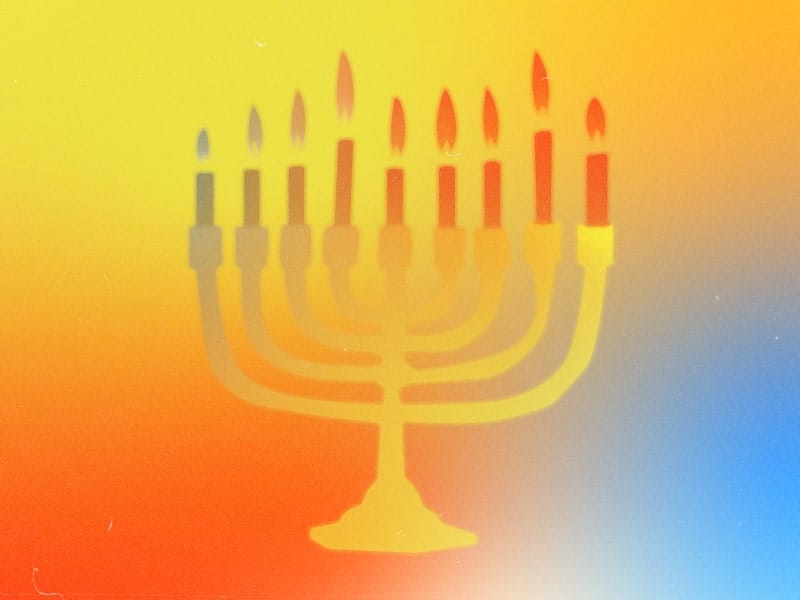Hanukkah
This eight-day festival of lights commemorates the rededication of the Holy Temple in Jerusalem and freedom from oppression.

This eight-day festival of lights commemorates the rededication of the Holy Temple in Jerusalem and freedom from oppression.
Nathaniel Glanzman
Reviewer URLName: Hanukkah, Chanukah, Festival of Lights
Pronunciation: Haa-nuh-kuh
This eight-day festival of lights commemorates the rededication of the Holy Temple in Jerusalem and freedom from oppression.
Origin
Hanukkah celebrates the recapturing of the Holy Temple in Jerusalem from the Seleucid empire. Ancient Israel was overtaken by a series of Hellenic kings, notably Epiphanes, who outlawed Judaism, burnt Torahs and tortured Jewish people throughout Israel. The Jewish people steadfastly refused to assimilate to the Hellenic empires that occupied them, practicing their faith and celebrating their culture even under tyrannical conditions.
In 168 BCE, an old priest named Mattathias and his sons, collectively known as the Maccabees, began to engage in guerrilla warfare against the Syrians. Led by Mattathias’ oldest son, Judah, the Maccabees were able to make headway within Israel. By 164 BCE, the Maccabees recaptured Jerusalem.
Hanukkah means “dedication,” referencing the rededication of the Holy Temple. When the Maccabees recaptured the Holy Temple, they sought to relight the temple’s menorah. The temple’s menorah, a seven-armed candelabra which required oil to be lit, had been extinguished. There was only one night’s worth of sacred oil left in the temple.
The Maccabees lit the menorah with this sacred oil and prayed it would last. Miraculously, it did, lasting eight days and nights. As a result, the Hanukkah celebration lasts eight days and nights. Hanukkah celebrates the miracle of the sacred oil as well as the freedom of the Jewish people from tyrannical rule.
Hanukkah is not an important religious holiday in Judaism, but it is a popular holiday culturally. The date of Hanukkah is determined by the Hebrew calendar and changes each year. It always falls in the autumn or winter months.
Hanukkah is one of the most popular holidays amongst American Jews. The popularization of Hanukkah grew in the 19th century, parallel with the popularization of Christmas. During this period of popularization, Hanukkah became a gift-giving holiday, overshadowing the traditional gift-giving holiday of Purim. Since 1979, a National Menorah has been lit in the Ellipse, across from the White House.
Traditions
Hanukkah has a number of traditions, the most important being the nightly lighting of the menorah. In Hebrew, menorah means lamp and usually references a seven-armed candelabra. Hanukkah menorahs, also called hanukkiyah, have eight arms. A Hanukkah menorah includes places for nine candles—one slot on each arm and a central slot for the shamash, the helper candle used to light the other candles each night.
The candles are placed in the menorah from right to left. On each night of Hanukkah, one candle is lit, from left to right. By the end of Hanukkah, all eight candles are lit. Each night, the candles are left lit in the menorah until they burn all the way down. Each day, new candles (including the shamash) are added. As families light the candles, they recite Hanukkah blessings. Boxes of Hanukkah candles come with at least 44 candles.
In synagogue services, rabbis will add a prayer of thanksgiving called the Hallel to their services on the first two days of Hanukkah.
In the United States, Hanukkah is a gift-giving holiday. Families will give children gifts on each night of Hanukkah. Families are also encouraged to give to charity during Hanukkah.
Children frequently play games with a dreidel, or spinning top. The dreidel has four sides, each decorated with a Hebrew letter. Children add candy to a central pot and spin the top. Depending on how the dreidel lands, children need to add an item to the pot, take half the pot, take the entire pot or do nothing at all.
Traditional Hanukkah foods are cooked in oil. These include latkes, or potato pancakes, and sufganiyah, or jelly donuts.
Hanukkah is also represented in entertainment, with many television shows offering holiday episodes. The Rugrats offered the first episode of children’s television about Hanukkah in 1996. The episode (titled “Chanukah”) tells the story of the Maccabees. Other shows with notable Hanukkah episodes include Friends and The OC, which pioneered their own Christmas-Hanukkah mashup holiday called “Chrismukkah.”
In popular culture, Hanukkah is associated with the colors of blue, white and silver.
What to say
“Hanukkah sameach” or “Happy Hanukkah” are appropriate holiday greetings.